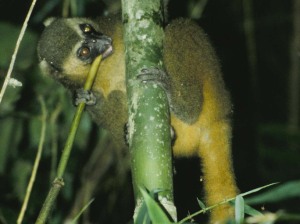 Three species of bamboo lemur exist in the same (and ever-shrinking) tiny area in Eastern Madagascar. They provide us with a singular example of adaptive radiation. All three eat bamboo, but in a very civil manner they feed on different parts of the plant. Why do they have to split the bamboo that way? Short answer: niche partitioning. A somewhat extended answer: closely related animals living in the same area (sympatric species) can not occupy the same biological niche (which can be a habitat or merely a certain type of food, like in this particular case), because sooner or later the stronger one would displace the other.
Three species of bamboo lemur exist in the same (and ever-shrinking) tiny area in Eastern Madagascar. They provide us with a singular example of adaptive radiation. All three eat bamboo, but in a very civil manner they feed on different parts of the plant. Why do they have to split the bamboo that way? Short answer: niche partitioning. A somewhat extended answer: closely related animals living in the same area (sympatric species) can not occupy the same biological niche (which can be a habitat or merely a certain type of food, like in this particular case), because sooner or later the stronger one would displace the other.
 Now, the gentle bamboo lemur (Hapalemur griseus) eats the leaves, while the greater bamboo lemur (H. simus), a more robust species, eats the pith of mature stalks. The golden bambo lemur (H. aureus) confines itself to the new shoots, leaf bases and the pith of narrow stems.
Now, the gentle bamboo lemur (Hapalemur griseus) eats the leaves, while the greater bamboo lemur (H. simus), a more robust species, eats the pith of mature stalks. The golden bambo lemur (H. aureus) confines itself to the new shoots, leaf bases and the pith of narrow stems.
Here’s the catch: the parts that H. aureus recklessly gobbles up contain cyanide. No small amounts of this lethal substance is consumed by this unheeding furry creature. About 4 mg/kg of body weight would certainly kill a dog. It has been estimated that the golden bamboo lemur eats 78 mg/kg on a daily basis. Scientists are understandably baffled at this self-poisoning behaviour and can only guess in what way the animal tackles it, for the digestive system of this species has never been studied. It is another great mystery of nature that remains to be revealed. But again, evolution through adaptive radiation has found a way to allow three very similar animals to co-exist peacefully.
Primary source: The Song of the Dodo by David Quammen, one of my favourite non-fiction books.